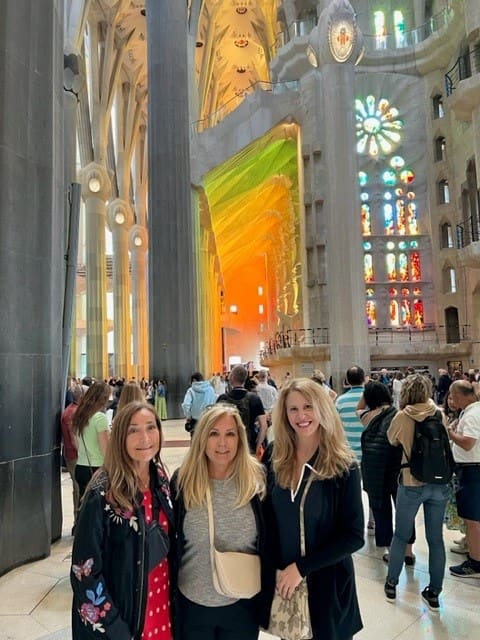What 21st Century Marketers Can Learn From a 19th Century Architect
I recently took a trip to Spain, allowing myself to unplug from work and get immersed in another culture.
Well, actually, I was looking forward to visiting wineries, eating great food, maybe relaxing poolside. But my travel mates had a different itinerary in mind.
And so, I found myself waiting in an incredibly long line to see the Basilica de la Sagrada Familia in Barcelona, designed by renowned architect and designer Antoni Gaudi.

What does this story have to do with marketing?
EVERYTHING.
How I Made the Leap from Architectural Sightseeing to Marketing
Born in 1852, Gaudi is the epitome of a man who was clearly ahead of his time. He broke rules and bucked tradition, allowing his passion for nature and religion to inspire and drive his work. The result is a collection of building designs that were simply never seen before.
His last major project, Sagrada Familia, is almost beyond description: The exterior alone was jaw-dropping, a building that is clearly trying to tell a story. Once inside, I was even more awestruck.
The mosaic windows alone proved worth the crowds and the long wait. They convey a story of how life differs at sun up vs sundown, with cool-colored glass capturing the start of the day along the east side of the building and warm, vibrant shades reflecting the setting sun along the west side.


Sure, it took great planning and technical skills to execute, but the concept was pure creativity. Whether you consider them beautiful or not, Gaudi’s designs are thoroughly original and distinct, tickling the senses and creating a near-spiritual, other-worldly experience.
Back in the states and back to reality, I thought: Surely there is something to be learned from a man whose work has stood the test of time for centuries and still inspires millions of visitors of all ages.
I took a pad of paper and pen out to my patio, left my phone and laptop inside, and just sat, gazing at my surroundings.
And then it hit me: Today’s tech-focused, data-driven, fast-paced world is making it increasingly difficult for marketers to apply their creativity. And without creativity, we’re destined to fail.
Is Modern Marketing Failing Us?
Marketing has evolved in many important and positive ways. Yet, some of the very approaches that make modern marketing effective have the potential to stifle our creativity in ways that could actually inhibit results.
It might sound counter-intuitive, but follow me down this path for a minute and see if you agree.
- Advanced analytics allow us to measure how marketing is performing and optimize every campaign for better results. But is the science of data overshadowing the creativity needed to stand out in a way that captures the buyer’s attention?
- Search algorithms give us the insight to improve search engine optimization and drive more traffic to a company’s website or other assets. But are these algorithms tamping down those most impactful creative leaps by making our marketing too formulaic?
- Generative AI tools like ChatGPT, Perplexity, and Claude can deliver a wealth of information that jumpstarts the content development process for efficiency. But do they have the potential to yield nothing but vanilla, copycat content that simply adds to the noise? (Full disclosure: I asked Claude to confirm whether my insights about the connection between Gaudi and marketing actually held up. This virtual assistant proved a great sounding board to test my theories! But at no point did Claude drive the idea or the content. That was Pure Deb!)
There are no black-or-white answers to questions like these, but my unscientific exploration of the state of marketing today says creativity leaves a lot to be desired. I see social media posts devoid of emotion. Blogs that clearly regurgitate whatever AI served up. White papers completely lacking any richness or insight. There’s often a safety and a uniformity to it.
That’s not what enables companies to stand out, especially in a crowded market. And it’s definitely not what inspires buyers or moves them to act.
How We Can Channel Our Inner Gaudi for Better Results
Marketers and the companies we serve can learn a lot from Gaudi’s work.
Here are five ways to start channeling this groundbreaking innovator and develop marketing that outperforms:
- Broaden your inspiration sources. I could have tucked away those memories of Spain as soon as I got back, but I have a tendency not to compartmentalize work vs life. If we move beyond the templates and data, and allow our life experiences to inspire our work, we’ll create marketing that helps companies stand out, gain the ideal buyer’s attention, and spur people to action.
- Get back to storytelling. Buyers don’t want to be sold; they want to be inspired, entertained, informed, and even amused. That’s why the most effective marketing almost always tells a story, much like Gaudi’s buildings. And that’s probably what drew you to this blog and kept you reading: I shared a story that sparked your curiosity and perhaps evoked an emotion.
- Take risks. Playing it safe might seem like the best way to avoid the risk of your marketing failing. But it’s actually the riskiest thing you can do. As I’ll explore in Gaudi Part 2, some sectors of the B2B world suffer from a risk-averse approach that creates a sea of sameness—exactly the opposite effect you want when you’re attempting to differentiate your services and drive buyers to choose you over competitors.
- Be thought-provoking. I almost always take a bold stance in my blogs, and never for shock value. I truly believe what I say, and I’m willing to share it publicly because I think it’s important to spark debate about critical topics. Some readers will agree with my point-of-view, others won’t, but that’s OK. The conversation itself is valuable, no matter the outcome.
- Slow down. In an age when speed is paramount and fast turnaround has become the norm, it’s easy to fall into the trap of marching quickly down a checklist of deliverables. But creativity takes time. You’re not going to create the next Rolling Stones-inspired “Start Me Up” campaign for Microsoft Windows 95 if you’re counting the minutes until you move on to the next task. I really had to force myself to sit quietly in my garden with seemingly nothing to do. But investing that time proved incredibly worthwhile, because it motivated me to take a fresh look at how the Marketri team operates on behalf of our clients.
I truly believe the most successful companies in the future will be those that make creativity a top priority and hold their marketing partners accountable to do the same. I’m inspired to infuse more creativity into everything we do at Marketri and I’m excited to see the results!
Schedule a call with Deb Andrews to learn how Marketri can combine strategy, creativity, and execution to drive predictable, profitable revenue.





